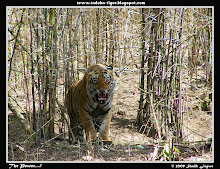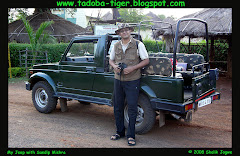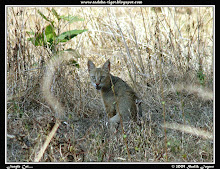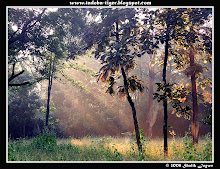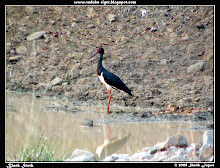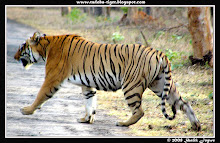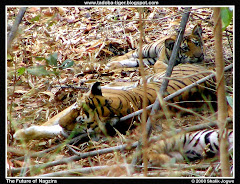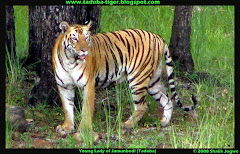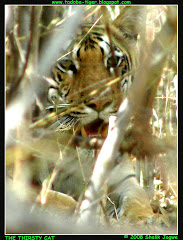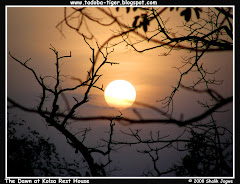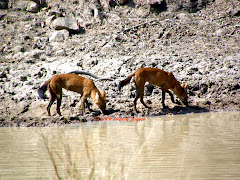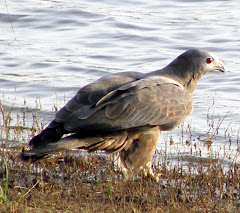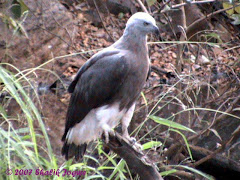Monday, September 8
Discussion on Tiger Shows
I have started this topic to discuss the fairness of Tiger Shows that happened in various Tiger Reserves across India.
In this Topic we are going to discuss about:
1) Fairness of Tiger Shows,
2) Radio Collaring to Tigers,
3) Violation of Fundamental rights of Animal's freedom specially Tigers,
4) Violation of freedom to live at it's own discretion,
5) Interference of Human being in animal world,
6) Causes and Impact of Human-Animal Conflict,
7) Conflict between Human Vs. Animal's Fundamental Rights; it's nature and Impact on both sides,
8) All other relative issues and suggestions which you feel important for Tiger Conservation and protection.
Dear Friends, I very earnestly request you to post your comments thoroghly. It will be your great help in conservation and protection of Big Cats.
Let's Make this Topic a big discussion Forum.
Friday, July 18
Tadoba-Andhari Tiger Reserve


Tadoba-Andhari Tiger Reserve is a pristine and unique eco-system situated in the Chandrapur district of the Maharashtra State located at a distance of 40 km from Chandrapur. The Reserve contains some of the best forest tracks and endowed with rich biodiversity. It is famous for its natural heritage. Tadoba-andhari Tiger Reserve is the second Tiger Reserve in the State 0f Maharashtra. Tadoba-andhari Tiger reserve was created in 1995. The area of the Reserve is 625.40 sq. km. This includes Tadoba National Park, created in 1955 with an area of 116.55 sq. km. and Andhari Wildlife Sanctuary created in 1986 with an area of 508.85 sq. km.
The name 'Tadoba' is the name of the God 'Tadoba'or "Taru", praised by the tribal which is supposed to live in the dense forests of Tadoba and Andhari region. Forest Types
Forest Types
Southern tropical Dry Deciduous
 This is a panoromic view of Tadoba's dry deciduous forest and the Tadoba reservoir, which is known as the 'Heart of Tadoba'.
This is a panoromic view of Tadoba's dry deciduous forest and the Tadoba reservoir, which is known as the 'Heart of Tadoba'.At least 31 people have been killed by tigers from Tadoba since April 2005, according to forest department records. But only two of these killings took place inside the reserve. The rest occurred in the thickly forested Mul, Shioni, Talodhi, Nagbhid and Brahmapuri forest ranges adjoining the reserve’s eastern border, where most villages are located and most roads are being built.
The attacks have affected the rural economy. Most villagers are wary of venturing into the forests to collect forest produce. In Talodhi range’s Jankapur village, where three persons were killed by tigers in recent years, half the villagers haven’t cultivated their land since June 2007.
Forest officials aren’t clear what’s prompting the attacks. Last November the department killed a supposed man-eater in Talodhi, but that didn’t stop the attacks. Poonam and Harsh Dhanwatey of the Tiger Research and Conservation Trust, who have been working in forests outside the reserve, suggest the attacks might be due to seasonal wildlife pattern changes. However, Amrut Dhanwatey, wildlife photographer and owner of the Tiger Trails resort on the western side of the reserve, says road-building and tourist activities is disturbing the tigers and their prey base and forcing the cats to move outside the reserve.
Both conservationists and forest officials allege local villagers’ forays in to the forests to graze cattle and collect forest produce is the lead cause of the attacks. Villagers also blame the development activities. Last year, for instance, Jankapur villagers lost around 485.6 ha to a canal being built as part of the Gosekhurd dam project. This included their entire grazing land and a village tank. Since they are losing land, villagers are forced to go into the forest to graze their cattle. “Officials don’t understand how crucial forests are for us,” says Dhondabai Kusram of Jankapur.
 The Gaur
The Gaur

Marsh Crocodile
 Serpent Eagle
Serpent Eagle
Acknowledgements: Satpura Foundation, Atul Dhamankar
Tuesday, May 13
Tadoba: Photographs
I have started a new blog to let you watch and enjoy the exclusive photographs taken by me from Tadhoba-Andhari Tiger Reserve.
I have also given the information about each photograph in the comment link. The link is given just below the photo. Please click it.
I hope you will Enjoy the photos.
Here you will also find the photos of the visitors whom I accompanied.
Please follow the following link to watch and enjoy.
PLEASE CLICK HERE
or enter the URL directly: www.tadobapictures.blogspot.com
Enjoy the Show....!
Saturday, May 10
Tadoba: Latest News
You can find here the Latest News about, in and around the area of, Tadoba-Andhari Tiger Reserve. If you have such any news concerned to the Wildlife protection, Conservation, Ecotourism, Poaching or such anything which you feel important please mail it to me at
tadobatiger@gmail.com
Please feel free to call me at +91 9420303020, +91 9595936369 , +91 9372069911
Monday, May 5
My Tadoba Visit
I am feeling very strongly since some days that there should be a specific post link in ROARING MELODY OF TADOBA TIGER where one can write his experience about Tadoba-Andhari Tiger Reserve.
So this is my initiative in the same direction.
Anybody can comment under this post.
Please be careful Post only your experience/Feelings/Suggestions while you were exploring Tadoba.
I hope SPECIALLY those people whom I assisted in exploring the Tadoba, Will comment here. It will help me in making proper arrangements for tadoba visitors to make their visit a lifelong unforgettable experience.
PLEASE CLICK HERE TO WRITE YOUR EXPERIENCE
Thank You.
Saturday, April 19
How to reach Tadoba
If you are planning to explore Tadoba, Keep in mind these routes to reach the sanctuary
You can reach Tadoba from Nagpur Via
1. Nagpur-Jam-Nandori-Kora-Khadsangi-Navegaon
2. Nagpur-Jam-Nandori-Warora-Khadsangi-Navegaon
3. Nagpur-Jam-Nandori-Warora-Shegaon-Mudholi-Mohurli
4. Nagpur-Jam-Nandori-Warora-Chandrapur-Mohurli
5. Nagpur-Umred-Chimur-Kolar
6. Nagpur-Umred-Chimur-Khadsangi-Navegaon
You can Reach Tadoba from Wardha Via
1. Wardha-Hinganghat-Nandori-Kora-Khandsangi-Navegaon
2. Wardha-Hinganghat-Nandori-Warora-Chandrapur-Mohurli
3. Wardha-Hinganghat-Nandori-Warora-Shegaon-Mudholi-Mohurli
All these are routes from Wardha.
You can Reach Kolsa from Nagpur/Wardha Via
1. Nagpur-Umred-Nagbhid-Sindewahi-Mul-Kolsa
2. Wardha-Hinganghat-Nandori-Warora-Chandrapur-Kolsa
You can come to Nagpur by Train/Flight/Bus
From Nagpur You can opt for Taxi/Bus/Train
You can Even Come Direct to Chandrapur By Rail
From Chandrapur You can avail a Taxi.
By train you can alight at Wardha station.
From Wardha You can take a Taxi/Bus/Train to Chandrapur.
FOR MORE DETAILS, INFORMATION AND ACCOMODATION FACILITIES
YOU CAN CALL ME ON 09420303020
OR mail me tadobatiger@gmail.com

